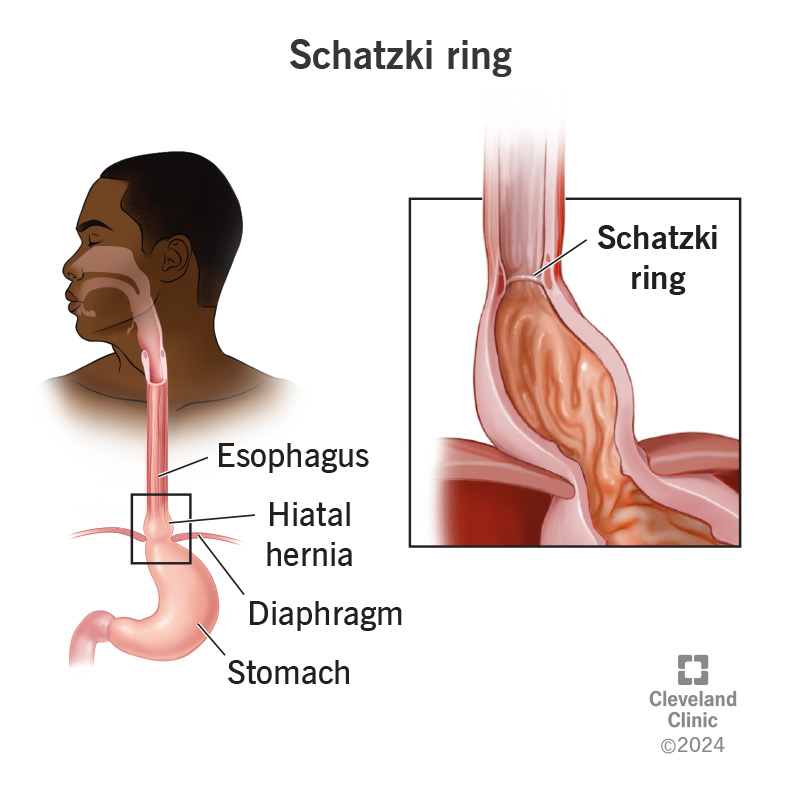A Schatzki ring is extra tissue that forms a circle on the inside of your lower esophagus. The ring narrows your esophagus so it may be hard for you to swallow food. Sometimes, food gets caught in your esophagus, causing sharp or burning pain. Healthcare providers may do procedures to stretch or remove the tissue.
Advertisement
Cleveland Clinic is a non-profit academic medical center. Advertising on our site helps support our mission. We do not endorse non-Cleveland Clinic products or services. Policy

A Schatzki ring is a ring or circle of extra tissue in your lower esophagus. If you have one, your esophagus narrows so it may be hard for you to swallow food (dysphagia). Your esophagus may become so narrow that food can’t pass through it to your stomach. The condition is named for radiologist Richard Schatzki, who discovered it.
Advertisement
Cleveland Clinic is a non-profit academic medical center. Advertising on our site helps support our mission. We do not endorse non-Cleveland Clinic products or services. Policy
Schatzki rings may not cause symptoms. You may learn you have one after a test for an unrelated issue with your esophagus. You may not need treatment unless the condition makes it hard for you to swallow.
Dysphagia is the main symptom. Other symptoms are:
Schatzki ring symptoms often happen when you eat dry bread or pieces of unchewed meat. Symptoms develop over time. They can start at any age, but usually begin after age 25.
It may be a congenital condition, meaning you’re born with it. But researchers think other things may cause Schatzki rings. For example, conditions that send stomach acid into your esophagus may be responsible. Experts think stomach acid or medication may irritate tissue in your lower esophagus. Over time, your body creates extra tissue at the spot where the stomach acid or medication stays in your esophagus. Conditions that may cause a Schatzki ring include:
Advertisement
A healthcare provider will do a physical exam. They’ll ask about your symptoms and if eating certain foods makes your symptoms worse. They may refer you to a gastroenterologist for diagnosis and treatment.
Your gastroenterologist may do an endoscopy to look at the inside of your esophagus. They may do a barium esophagram. This is a fluoroscopic X-ray of your esophagus. This test lets your provider watch what happens when you swallow a barium tablet. They may call this a barium swallow test. The test lets your gastroenterologist estimate the size of the ring.
The wider the ring of tissue, the narrower your esophagus becomes. That makes it more difficult for food to move to your stomach.
Your gastroenterologist may do an esophagogastroduodenoscopy (EDG) with esophageal dilation. They’ll use an endoscope to guide a balloon or dilator into your esophagus. An endoscope is a long, thin tube with a light and camera. The balloon or dilator expands to stretch the ring of tissue.
An EDG with esophageal dilation may cause side effects like:
Very rarely, esophageal dilation may tear a hole in your esophagus. Contact your gastroenterologist right away if you:
Esophageal dilation typically keeps the Schatzki ring from trapping food in your esophagus. The treatment makes it easier for you to swallow. The ring can come back, so you may need a follow-up procedure.
A Schatzki ring can make it hard to swallow food, especially dry bread and chunks of unchewed meat. Your gastroenterologist may recommend you focus on soft foods before and after treatment.
You should contact your gastroenterologist if your symptoms come back. They may do tests to confirm that a Schatzki ring is redeveloping in your esophagus.
No, it doesn’t go away on its own. Treatment is the only way to make a Schatzki ring go away. Even then, the condition may come back so you need more treatment.
Advertisement
You may look forward to meals as a time to relax, enjoy good food and good company. A Schatzki ring in your esophagus can make it hard to swallow. And that can make mealtime something to endure rather than enjoy. Treatment can ease Schatzki ring symptoms. If tests show you have this condition, ask your provider what treatment makes sense for you. They’ll be glad to discuss options and explain what you can expect.
Advertisement
If you have conditions affecting your ears, nose and throat, you want experts you can trust. Cleveland Clinic’s otolaryngology specialists can help.

Last reviewed on 04/21/2025.
Learn more about the Health Library and our editorial process.